Let’s close this introduction by looking at some of the broadest and deepest ways that philanthropy makes our lives and our nation better. I don’t mean the good done to recipients of aid, or the pragmatic value of donated money and time, or other obvious advantages. In this final section we’ll look at some of the philosophical, moral, and political gains to America that grow out of our giving tradition.
Private giving satisfies deep human needs
It’s easy to overlook the fact that philanthropy doesn’t just help the recipients—it offers profound life satisfaction to givers as well. It opens avenues to meaning and happiness and ways of thriving that aren’t easily found otherwise. When I was in college I had a philosophy professor named Louis Dupre who told me a story I’ve never forgotten. He had a wonderfully generous friend from whom he eventually fell away for the most paradoxical reason: this friend was unable to let Dupre be generous and giving in return. Receiving gifts and favors can be lovely, but there is also a potent and irreplaceable joy of giving that most people need to express.
The joy of giving is captured frequently in literature:
It is one of the most beautiful compensations of life that no man can sincerely try to help another without helping himself.
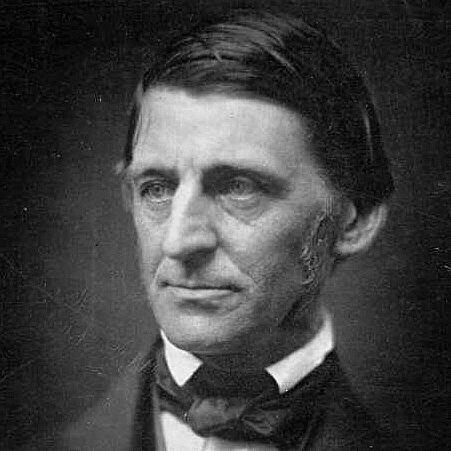
As the purse is emptied the heart is filled.
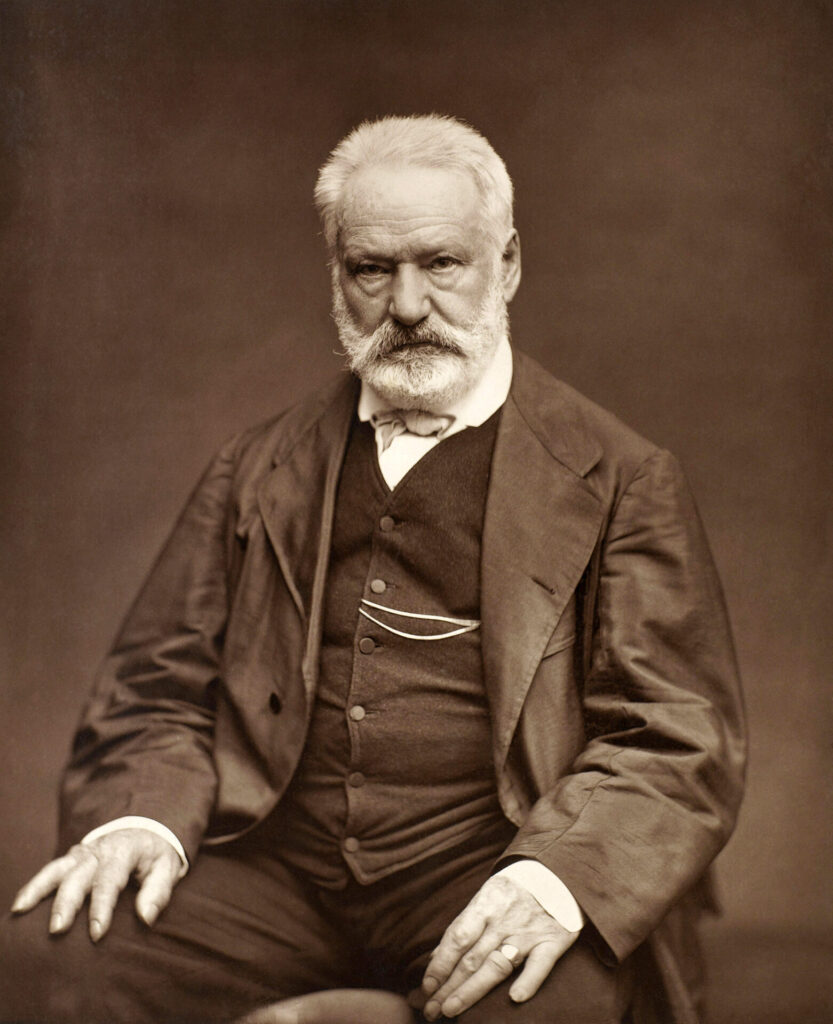
If you want happiness for a year, inherit a fortune. If you want happiness for a lifetime, help someone else.
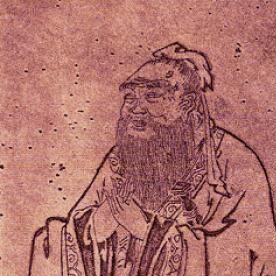
The best recreation is to do good.
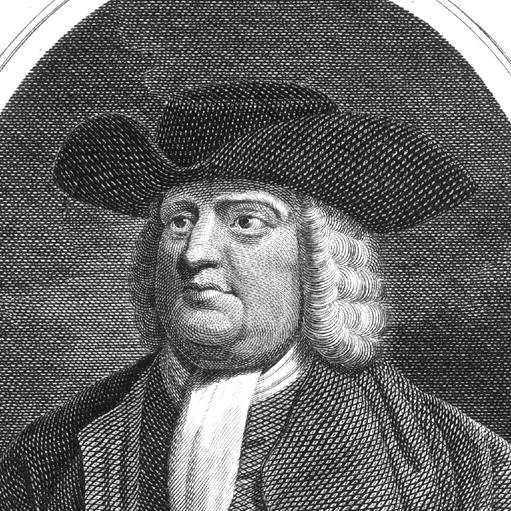
If you want to lift yourself up, lift up someone else.
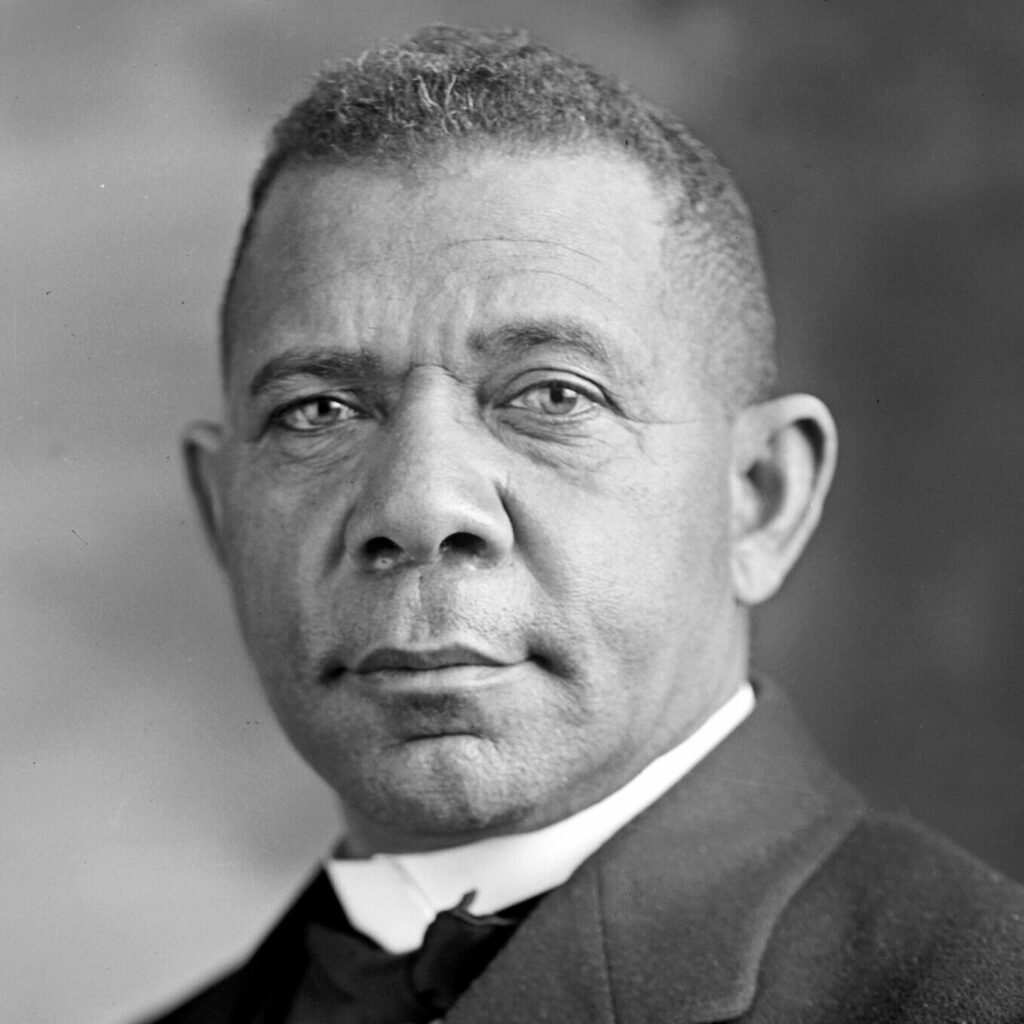
A man there was, though some did count him mad, the more he cast away, the more he had.
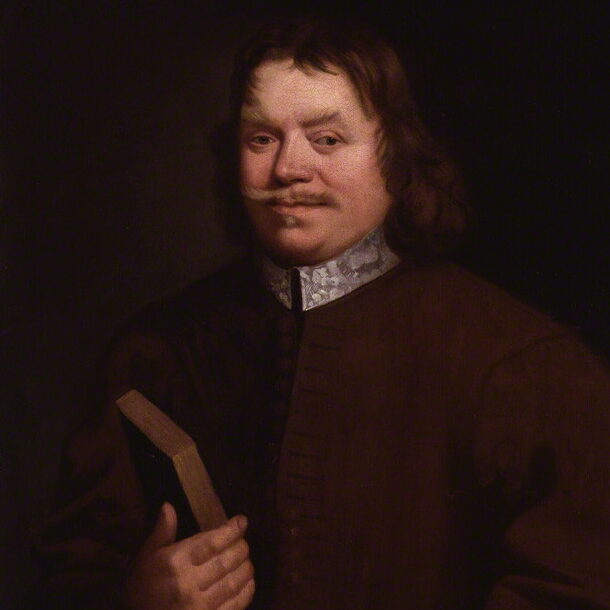
Giving is an ancient impulse. Way back in 347 B.C., Plato donated his farm to support students at the school he founded. It is also a widespread impulse. Even people who have very little money are eager to give, and feel good when they do, as documented in several places later in this Almanac.
The book Breaking Night tells the true story of a neglected girl and the kind people who intervened to help her succeed in spite of her horrendous upbringing. “What was most moving about all of this unexpected generosity,” writes the now-grown child, “was the spirit in which people helped. It was something in their moods and in their general being…how they were smiling, looking me right in the eyes.”
Without the passion and resources devoted to philanthropy, our days would be flatter, darker, uglier, more dangerous, and less happy.
She describes a woman named Teressa who came up to her and said, “Since I didn’t have any money to help you out, I thought I couldn’t do anything for you at all. And then last night, I was doing my daughter’s laundry, and I thought, how silly of me, maybe you had laundry I could do for you.” Every week for the remainder of the author’s time in school, Teressa picked up dirty clothes and returned them clean and folded, taking great pleasure in this little thing she could do to help.
Lots of research shows that this is a common phenomenon. A 2014 book by two Notre Dame social scientists called The Paradox of Generosity combined national surveys with in-depth interviews and group observations. It concluded that “the more generous Americans are, the more happiness, health, and purpose in life they enjoy. This association…is strong and highly consistent…. Generous practices actually create enhanced personal well- being. The association…is not accidental, spurious, or an artifact of reverse causal influence.” They conclude with the observation that “People often say that we increase the love we have by giving it away…. Generosity is like love in this way.”
In a 2008 paper published in Science, three researchers gave study participants money, asking half of the group to spend it on themselves, and the other half to give it to some person or charity. Those who donated the money showed a significant uptick in happiness; those who spent it on themselves did not. In his book Who Really Cares, economist Arthur Brooks cites a host of similar studies showing that Americans who make gifts of money and time are much more likely to be satisfied with life than non-givers who are demographically identical.
Private giving improves capitalism
Capitalism and philanthropy have always been closely tied. In the 1600s when the Netherlands was gestating free trade and many modern business patterns, there were alms boxes in most taverns (where business negotiations generally took place), and a successful deal was expected to conclude with a charitable gift.
Philanthropy and business are entwined especially tightly in America. One of the most distinctive aspects of American capitalism is the deep-seated tradition of philanthropy that has evolved among American business barons. Our capitalism also differs from the capitalism practiced in other countries in two other important ways—in its linkage to religiosity, and its preference for entrepreneurial forms. Both of these are also connected to philanthropy.
Let’s unpack this a bit, starting with religion. In 2014, the Pew Research Center released data comparing the per capita wealth of nations with the religious beliefs of their people. The U.S. stands out like a sore thumb:
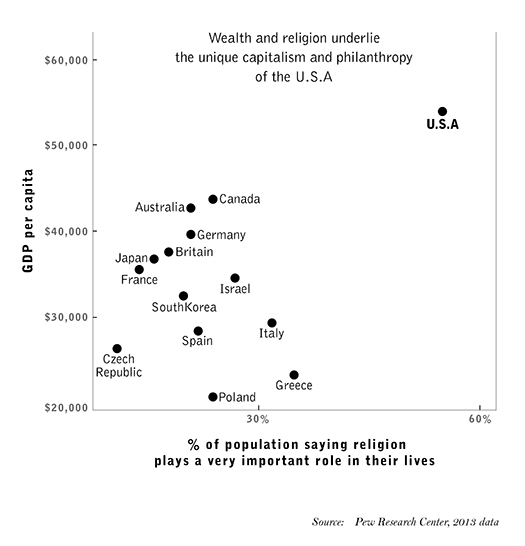
The Calvinism that came to the U.S. with the Pilgrims (and continued to dominate our religious views for generations right up to the present) treats wealth as something that passes through the hands of a successful person—with the steward expected to apply it to uplift his fellow man. Thus John Rockefeller gave away 95 percent of his fortune by the time he died. Bill Gates is in the process of giving away tens of billions of dollars, leaving his three children only $10 million each.
That is different from the pattern in Europe, where many of the same dynasties have dominated the rolls of the wealthy for generations. The Howard family, for instance, has been one of Britain’s richest for more than 500 years. In the U.S., wealth tends to be extremely transient. Only 15 to 20 percent of the individuals on today’s Forbes list of richest Americans inherited wealth. About half the the Forbes 400 had parents who didn’t go to college at all. Even the foundations left behind by the previously wealthy rapidly get eclipsed in America: the Rockefeller Foundation, once our richest, now ranks a mere number 15, while the Carnegie Corporation has fallen to number 24.
A second distinctive aspect of American capitalism is its entrepreneurial bent. As economists Zoltan Acs and Ronnie Phillips write, “American capitalism differs from all other forms of industrial capitalism” in two ways. One is its emphasis on the creation of new wealth via entrepreneurship. New firms, new ideas, and nouveau riche wealthmakers are at the core of our economic success.
This can be demonstrated in many ways. If you look at the 500 largest companies in the world today, you find that 29 percent of the U.S. firms were founded after 1950, compared to just 8 percent of the European firms. On a per capita basis, the U.S. has four times as many
self-made billionaire entrepreneurs as Europe.
Entrepreneurialism and philanthropy are often tightly connected, and linked directly with economic success. In their book Super Entrepreneurs, Swedish researchers Tino and Nima Sanandaji investigated about 1,000 self-made billionaires from around the world. They found “a very strong correlation” between entrepreneurship, wealth, and philanthropy.
Acs and Phillips argue that in addition to its distinctive means of creating wealth through new enterprises, the U.S. has a distinctive means of “reconstituting” wealth via philanthropy. “Philanthropy is part of the implicit social contract that continuously nurtures and revitalizes economic prosperity,” they write. Philanthropy is a very important mechanism for recycling wealth in America, agree the Sanandajis. “The notion exists that wealth beyond a certain point should be invested back in society to expand opportunity for future generations,” they write. “ ‘The legitimacy of American capitalism has in part been upheld through voluntary donations from the rich’…. Much of the new wealth created historically has thus been given back to society. This has had several feedback effects on capitalism. For one, the practice has limited the rise of new dynasties. Another positive feedback mechanism is that the donations to research and higher education have allowed new generations to become wealthy.”
Private giving strengthens democracy
Civil society and charitable action sprang up in the U.S. even before government did. In most of our new communities, mutual aid among neighbors was solving problems long before there were duly constituted agencies of the state.
Americans of all ages, all conditions, and all dispositions constantly form associations…religious, moral, serious, futile, general or restricted, enormous or diminutive. The Americans make associations to give entertainments, to found seminaries, to build inns, to construct churches, to diffuse books, to send missionaries to the antipodes; in this manner they found hospitals, prisons, and schools. If it is proposed to inculcate some truth or to foster some feeling by the encouragement of a great example, they form a society. Wherever at the head of some new undertaking you see the government in France, or an aristocrat in England, in the United States you will be sure to find an association.
Can anything large and consequential really be accomplished by little and middling givers, or by the very limited population of big givers? The clear answer from American history is yes.
That was Tocqueville’s observation in Democracy in America close to 200 years ago.
As the title of the French visitor’s book suggests, what impressed him about voluntary action in the U.S. was not just its practical ability to solve problems, but the way it exercised and built up the social muscles needed if people were to govern themselves in a healthy democracy. Tocqueville considered American voluntary associations not just signs, but the source, of effective self-rule. He wished aloud that this American tradition could be transferred to Europeans, who had lost “the habit of acting in common” on their own, due to generations of smothering by the state.
Some people, Tocqueville wrote, claim that as the citizens become weaker and more helpless, the government must become proportionately more skilled and active, so that society should do what is no longer possible for individuals…. I think they are mistaken…. The more government takes the place of associations, the more will individuals lose the idea of forming associations and need the government to come to their help. That is a vicious circle of cause and effect…. The morals and intelligence of a democratic people would be in [danger]. Feelings and ideas are renewed, the heart enlarged, and the understanding developed only by the reciprocal action of men upon another.
Edmund Burke also viewed local association as the nursery for broader loyalty to one’s fellow man. “The little platoon we belong to in society is the first principle (the germ as it were) of public affections. It is the first link in the series by which we proceed towards a love to our country, and to mankind,” he wrote.
The great advantages that accrue to America from possessing a bubbling voluntary sector that acts independently have been under threat since the Great Depression, cautions author Richard Cornuelle. The economic crash gave American confidence a knock and planted the idea that “only government seems big enough” to solve serious social issues. “Our habit of sending difficult problems to Washington quickly became almost a reflex” and parts of the public and some of our leaders have turned their back on our deep tradition of indigenous alternatives to government action.
Cornuelle complains that we often now speak of American life in terms of only two “sectors”: the public sector (government), and the private sector (commerce). We leave out the third sector in our national life, the one which is neither governmental nor commercial. We ignore the institutions which once played such a decisive part in the society’s vibrant growth…[which] made it possible for us to build a humane society and a free society together.
This third sector, operating in the space between the individual and the state, between the coercion of law and the profit-seeking of commerce, goes by various names: civil society, the voluntary sector, charitable action. Back in 1970, the Peterson Commission pointed out the crucial need for “institutions standing outside the frame of government but in support of the public interest.” Cornuelle called these philanthropic institutions the “independent sector,” and warned that they have
a natural competitor: government. Both sectors operate in the same industry: public service and welfare…. The quality of life in the U.S. now depends largely on the revival of a lively competition between these two natural contenders for public responsibility. The struggle would enhance the effectiveness of both.
In some quarters, Cornuelle observes, the very idea of competition with government is, by a weird public myth, thought to be illegitimate, disruptive, divisive, unproductive, and perhaps immoral…. Far from being illegitimate, lively competition with government is essential if our democratic institutions are to work sensibly….
The government doesn’t ignore public opinion because the people who run it are naturally perverse. It isn’t wasteful because it is manned by wasteful people…. Without competition, the bureaucracy can’t make government efficient…. Innovation painfully disrupts its way of life. Reform comes only through competitive outsiders who force steady, efficient adjustment to changing situations.
The independent sector will grow strong again when its leaders realize that its unique indispensable natural role in America is to compete with government. It must be as eager as government to take on new public problems.
There are times and places where governmental rulers feel threatened by the philanthropic process. Philanthropy practiced on a mass level, as in America, becomes a kind of matrix of tens of thousands of private legislatures that set goals and priorities, define social ills, and methodically marshal money and labor to attack them—without asking the state’s permission. Some rulers prefer dependent citizens who are consumers rather than producers of governance.
Certainly tyrants hate philanthropy. They want the state to be the only forum for human influence and control. “Everything within the state, nothing outside the state, nothing against the state,” was Mussolini’s encapsulation. Independent associations and private wielders of resources must be co-opted or suppressed. The charitable sector is not only denied a seat at the table, it is put on the menu to be eaten. One of the first things every totalitarian government has done upon assuming power—from Nazis, to communists, to radical imams—is to destroy charities, private giving, and voluntary groups.
We’re seeing the same phenomenon today in authoritarian countries like Russia, China, and Iran, where charities are being shut down out of fear that they will provide alternate sources of ideas, cultural solutions, and social legitimacy. Only the freest societies have had flourishing philanthropic sectors. In America, our freedom to expend charitable resources without supervision or control is ultimately sheltered by the First Amendment of our Bill of Rights, which protects our right to assemble and act outside of government, to dissent, to take heterogeneous, unpopular, or minority- supported action to redress grievances.
Philanthropists come in all stripes. That’s one of the field’s strengths: Different givers pursue different visions, so you get many solutions to problems rather than just one.
Enlightened, practical, democratic leaders shouldn’t just tolerate the independent actions of donors and volunteers, they should embrace and encourage them. Social entrepreneur Neerav Kingsland, who gained prominence by helping build the nation’s most extensive web of independent charter schools in New Orleans after the Katrina disaster, has argued that the most effective and humane thing that many public servants can do today to help needy populations is to let go of their monopolies on power. He uses the term “Relinquishers” to describe progress-minded officials who are willing to transfer authority away from centralized bureaucracies in order to allow experimentation and improvement driven by philanthropy, commerce, grassroots activism, and other independent forces.
To illustrate how quickly societal conditions can improve when intelligent Relinquishers cede power to civil actors, Kingsland cites examples from the U.S. and abroad. He charts the explosion of per capita income in India since 1991, where economist and then Prime Minister Manmohan Singh promulgated new policies that made him “one of the greatest Relinquishers of the modern world. Over the past 20 years, his work in transferring power to India’s citizens…improved the well-being of hundreds of millions.”
Another Relinquisher triumph unfolded in New Orleans after philanthropists were allowed to pour resources and expertise into restructuring that city’s schools. Government continued to provide funds, fair rules, and accountability, but it allowed independent operators to take over the running of classrooms and academies. The result was that the number of classroom seats rated “high-quality” quadrupled in four years. The fraction of students testing at the proficient level leapt from 35 percent to 56 percent. The ACT scores of graduating seniors hit an historic high.
Sharing responsibility for societal improvement with funders and volunteers in civil society will often be a government policymaker’s speediest path to excellence and success—as well as a more democratic course.
It’s not wise to rely solely on government
“Every single great idea that has marked the twenty-first century, the twentieth century, and the nineteenth century has required government vision and government incentive.” That was former Vice President Joe Biden. “The ballot box is the place where all change begins in America.” That was former Senator Ted Kennedy.
These speakers overlooked the vast improving powers of free enterprise. (Government didn’t produce the air conditioning that transformed the South, or the mobile phone that is now revolutionizing everything from news to conversation to human attention spans.) They also ignored the profound role of independent philanthropy in altering American history.
Gifts where the giver and recipient are involved with each other, familiar with one another’s character, committed to each others’ flourishing, are some of the most successful forms of philanthropy.
Let’s take the civil-rights movement—a favorite example of advocates who would have you believe that nothing good happens unless government does it. Back in 1704—when 1,500 African Americans in New York City were held as slaves with full government sanction, and educating them was forbidden, private donors set up schools to instruct hundreds of slaves on the quiet. In the early 1830s, when state and federal governments still made it a crime to teach a slave to read, private donors like Arthur Tappan were paying for African Americans to go to college.
Less than two years after the bullets of the Civil War stopped flying, philanthropist George Peabody was distributing millions of his own dollars across the South to train teachers and set up schools without racial considerations so that freed slaves and other illiterate people could get education—despite the ferocious antipathy of state and local governments for that cause.
In 1891, philanthropist Katharine Drexel gave her entire fortune (half a billion dollars in contemporary terms) to create a new religious order devoted to assisting blacks and Indians. She established 50 schools for African Americans, 145 missions and 12 schools for Native Americans, and the black college Xavier University in New Orleans. In these same years, governments at all levels were doing little more than breaking promises to Native Americans and neglecting African Americans.
As the twentieth century opened, hundreds of governments were fiercely enforcing Jim Crow laws that stunted the education of blacks. But John Rockefeller was pouring money into his new General Education Board for providing primary education to African Americans. Then he boosted up 1,600 new high schools for poor whites and blacks. He eventually put almost $325 million of his personal fortune into the venture. Simultaneously he was spending millions to improve the health of poor blacks and whites by nearly eliminating hookworm.
Numerous private givers followed the leads of George Peabody and John Rockefeller and donated millions of dollars to improve the education and social status of African Americans at a time when they had no friends in government. The philanthropic help came from Anna Jeanes’s Negro Rural Schools Fund, the Phelps Stokes Fund, the Virginia Randolph Fund, the John Slater Fund, and others. These all continued their work until government finally caught up and started desegregating schools in the 1960s.
African-American children whose education and social conditions were being wholly neglected by the state got their biggest lift of all from philanthropist Julius Rosenwald. Starting in 1912, he donated the current equivalent of billions of dollars to build schoolhouses in hundreds of counties where black education was ignored. In less than 20 years, the Rosenwald program erected 4,977 rural schools and 380 companion community buildings in most of America’s locales with a substantial black population. At the time of Rosenwald’s death in 1932, the schools he built were educating fully 27 percent of all the African-American children in our country.
Many economic producers and sensible leaders were produced by these philanthropic projects. Absent these private efforts by donors, racial improvement and reconciliation in our country would have been delayed by generations. Government not only had little to do with this philanthropic uplift—many arms of government did their very best to resist or obstruct it.
A curmudgeon might say, “Well that’s nice, but it’s ancient history. Today, the government leads all necessary change.” That is gravely mistaken.
Guess where America’s most segregated and often most inadequate government-run schools are located at present? All in Northern cities with activist governments: Detroit, Milwaukee, New York, Newark, Chicago, and Philadelphia, research shows. According to the UCLA Civil Rights Project, New York is the state with the country’s most segregated schools—thanks to New York City, where the proportion of schools in which at least 90 percent of the students are black or Hispanic rose sharply from 1989 to 2010.
The government-operated schools in New York City drip with rhetoric about “social justice.” But it is private philanthropy that is shaking up the city’s complacently bad educational establishment today—by launching charter schools. As of 2016, there were 106,600 New York City children in charters, nearly all of them minorities and low-income, and 44,000 more remain on waiting lists. Stanford investigators and others find that these children are receiving significantly better educations than counterparts in conventional government-run schools, in some cases outscoring comfortable suburban schools in annual testing. Yet donors and charter-school operators continue to have to fight through the resistance of reactionary progressives in city hall and the New York City Council.
Or let’s look at another area where conventional wisdom says nothing important will happen except under governmental banners: Who saved the refugees disrupted by the two World Wars and the ethnic genocides of those decades? When the U.S. Ambassador to Turkey discovered that Ottomans were starving and killing Jews in Palestine, he sent an urgent telegram to philanthropist Jacob Schiff in New York. A fundraising committee was set up, and over the years to come it distributed hundreds of millions of dollars, donated by more than 3 million private givers, saving many thousands of Jews.
It wasn’t only Jews who needed saving. At that same time, Muslims were carrying out a jihad against Armenian Christians that ultimately took 1.5 million lives. The U.S. government did little, but everyday Americans, missionaries, church members, and philanthropists sprang into action to both save lives immediately and then sustain the Armenians dislocated by the genocide. Nearly 1,000 Americans volunteered to go to the region to build orphanages and help refugees. They assumed responsibility for 130,000 mother- and fatherless children, and rescued more than a million adults.
However often it grows out of pain, philanthropy is even more frequently sparked by opposite emotions like gratitude and joy.
It was a similar story when fascism swept Europe. The U.S. government dragged its feet and failed to organize any speedy effective effort to save the Jews, gypsies, Christians, and others targeted by the Nazis. Private donors jumped into the breach. The Rockefeller Foundation, for instance, established two special funds that worked, under the most difficult wartime conditions, to relocate mortally endangered individuals to Allied countries.
As with our civil-rights example, philanthropy taking up crucial burdens in the face of government failure is not just a story in the past tense. In 1993, all Western governments were pathetically slow and inadequate in their response to the ethnic cleansing in Bosnia that killed tens of thousands. The most effective actor by far was philanthropist George Soros—who used $50 million of his own money to insert a highly effective relief team into the city of Sarajevo while it was under siege, re-establishing gas and electric service during the bitter winter, setting up an alternate water source, and bringing in desperately needed supplies. It has been estimated that Soros’s gift saved more lives than the efforts of all national governments plus the United Nations combined.
The list of great ideas and dramatic improvements instigated by philanthropy while government was AWOL could be expanded endlessly, from the Green Revolution and invention of microlending abroad, to domestic achievements like the recovery of desolated urban parks, control of drunk driving, and creation of the country’s best job-training programs for economic strugglers. And philanthropic change tends to come with much less friction. As one social entrepreneur has put it, philanthropy generally practices “the politics of addition and multiplication,” while government action often comes via “the politics of subtraction and division.”
Why philanthropy is indispensable to American freedom
Let’s open this final section with a bit of extended historical analysis by Richard Cornuelle, from his book Reclaiming the American Dream:
We wanted, from the beginning, a free society, free in the sense that every man was his own supervisor and the architect of his own ambitions. So our founders took pains to design a government with limited power, and then carefully scattered the forces that could control it.
We wanted as well, with equal fervor, a good society—a humane, responsible society in which helping hands reached out to people in honest distress, in which common needs were met freely and fully. In pursuit of this ambition, Americans used remarkable imagination. We created a much wider variety of new institutions for this purpose than we built to insure political freedom. As a frontier people, accustomed to interdependence, we developed a genius for solving common problems. People joined together in bewildering combinations to found schools, churches, opera houses, co-ops, hospitals, to build bridges and canals, to help the poor. To see a need was, more often than not, to promote a scheme to meet it better than had ever been done before.
The American dream was coming true. Each part of it supported another part. We were free because we limited the power of government. We prospered because we were free. We built a good society because our prosperity yielded surplus energy that we put directly to work to meet human needs. Thus, we didn’t need much government, and because we didn’t, we stayed uniquely free. A sort of supportive circle, or spiral, was working for us.
The part of the system least understood, then as now, was the network of non-governmental institutions that served public needs. They did not leave an easy trace for historians to follow. They did not depend on noisy political debate for approval, nor did civil servants have to keep very details records of what they did. [Yet] they played a significant role…. They took on almost any public job and so became the principal way Americans got things done.
For years the leading colleges and universities were created by the churches. Hospitals began in a variety of ways, and in the era before the Civil War, under Clara Barton’s leadership, they blossomed into today’s major system of independent institutions. Many of our giant commercial firms, notably in insurance and mutual savings, grew out of early self-help organizations.
Urgent problems filled the agenda of public business in early America. Citizens, acting on their own, took the heavy load. Localities and states took most of what was done by government. We rarely needed the federal government, a distant thing to the frontiersman. We limited government, not only because people knew its limitations and wanted it limited, but because we left little for it to do.
As the great social thinker Michael Novak once put it: “The secret to the psychology of Americans is that they are neither individualists nor collectivists; their strong suit is association, and they freely organize themselves, cooperate, and work together in superb teamwork.” Novak points out that “the social system of the United States is constituted of three independent, yet interdependent, systems of institutions, organized along different axes and even different values: A political system. An economic system. And a moral-cultural system.” Our politics and economy are freedom-focused. Our moral-cultural system is focused on goodness, decency, and fairness.
These descriptions of America’s social order, and its dual devotion to freedom and goodness, are helpful in understanding why philanthropy is indispensable to American society. I view it as indispensable in two senses: 1) Philanthropy is not able to be replaced by something else. And 2) bad things will happen to the nation if it is not adequately continued.
The aspect of America that many of us cherish most is the latitude allowed individuals to chart their own course, to be responsible for themselves, sometimes to reinvent themselves if they choose and are able. Historically, this degree of individual independence and freedom is highly unusual. Every preceding society was in one fashion or another paternal. On the wide spectrum stretching from starchy monarchy to socialist beehive, all pre-American governments basically took responsibility for every individual, and in return reserved the right to tell him or her how to live. More specifically, a small caste of strongmen at the top of the heap (king, tribal chief, warlord, bishop, emperor) told everyone else how to live.
One can’t really claim that’s unfair—it’s how all but a thin sliver of humanity has always existed. The individual liberty and self-reliance carved out in America was the anomaly. And one of great preciousness, because it has allowed a quality of life and existential autonomy never approached by people in other times and places.
Our non-paternalized freedom is also a somewhat frail arrangement, however. For the reality is that all of us will occasionally misuse our independence in various ways, and a substantial minority of us will make a complete hash of our lives under a system of profound freedom. And when elderly profligates start dying in the street, or neglected children peer up at us with starving eyes, all the old solutions to governance will immediately be proposed.
Monarchy or socialism or blanketing welfare-state all boil down in one way or another to setting up a paternal fief under which individual freedoms will be traded away in exchange for more secure and predictable lives. Then the shirkers and the drunks and the abandoned are no longer at risk of perishing on the street. But personal liberties also evaporate, and the ceiling under which we must all fly falls down to match the lowest common denominator. Life becomes less risky, but all citizens are debased—not only the failures who are henceforth ordered how and where to live, but also everyone who had succeeded independently, and even members of the master class who must cage and feed the failures. All experience a decline in dignity, self- determination, and life satisfaction.
Lovers of freedom object: “That’s too high a price, we must therefore let the failures fail, else our whole system will tumble into busybodying oppressiveness.” But stepping over wasted children or dead bodies will soften many citizens to the idea of trading independence for security. Which is why nearly all human societies have ended up in one of the many paternal structures.
It’s just a fact of human empathy: one way or another, the miserable must be lifted up from the sidewalks where they sprawl. Common decency will not tolerate the alternative. Yet when the lifting is done in conventional collective ways, it leads to enslavement on both sides of the transaction.
It was voluntary action and private giving that allowed America to escape this terrible dilemma. We made the magical discovery that voluntary action can be a non-enslaving kind of paternalism, enabling us to meet Judeo-Christian and humanitarian responsibilities to fellow men without setting in motion the statist spiral which kills individual sovereignty. In solving basic security hungers and primal fears of a “jungle” freedom, philanthropy thus enabled enormous liberty. Philanthropy turned out to be indispensable to personal independence and national success. It kept America functioning as that exceedingly rare society where average people can steer their own lives.
This is why philanthropists are different from doctors, or teachers, or businessmen, who also do social good, and different from soldiers or ministers or others who sometimes sacrifice their own interests to aid fellow citizens. Doctors, businessmen, and soldiers are valuable contributors, but they are not essential to maintaining America’s basic social contract. They are not indispensable.
Effective philanthropists are indispensable. They allow us to have a good society without a paternalist state. They are the prophylactic against public lurches for freedom-killing security blankets.
Philanthropy is the guardian of our self-rule. It is one of just a few sine qua nons essential to our national health. Without it there is no America as we know it.
As you amble through the multifarious and sometimes quirky human actions described on the pages of The Almanac of American Philanthropy, and absorb the colorful stories of charity as it has been practiced in our land over four centuries, I hope you will also keep sight of this profound reality that underlies voluntary giving in America.